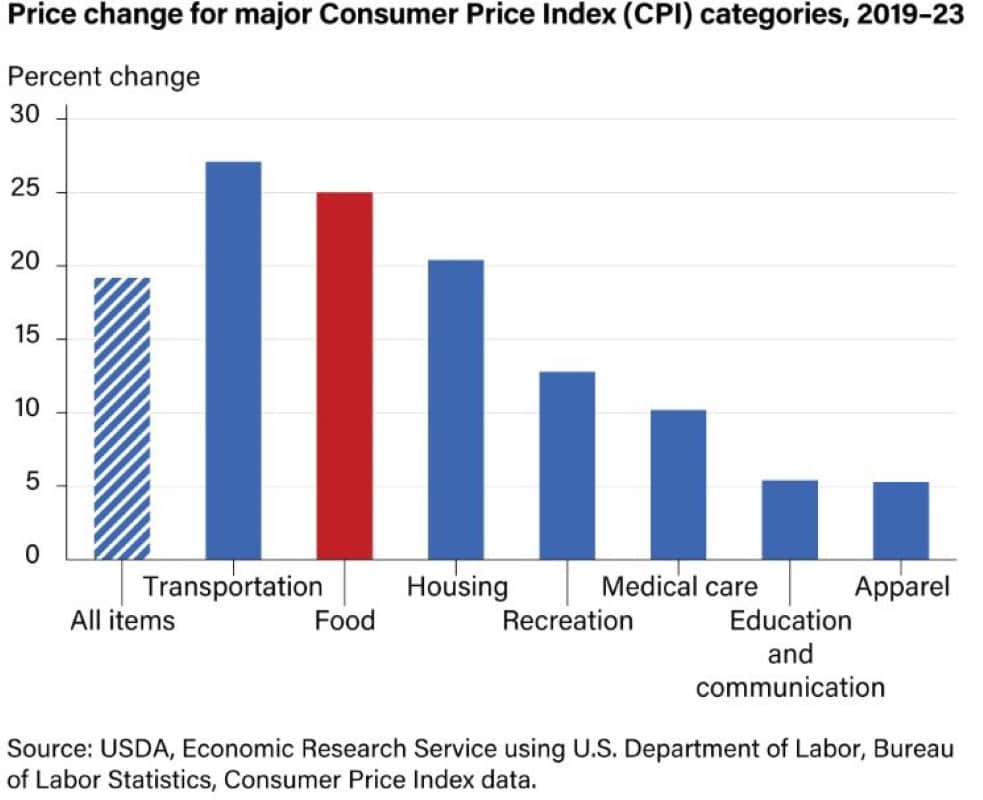Boomers and Gen X Grapple With Grim Reality as Nearly Half Fear They May Never Retire

Recent findings from the 2023 Employee Benefit Research Institute (EBRI) survey paint a troubling picture of the nation’s retirement outlook, echoing anxieties not seen since the 2008 financial crisis.
The survey reveals that 80% of workers anticipate a recession within the next year, while a staggering 90% are grappling with fears of prolonged high inflation. These mounting concerns underscore a growing uncertainty about achieving financial security during retirement.
Inflation Continues To Cast a Shadow

The EBRI Retirement Confidence Survey reveals that the specter of inflation looms large over Americans, with a vast majority—84% of workers and 67% of retirees—alarmed by the escalating cost of living that complicates their savings efforts.
The most recent inflation numbers show that prices are still rising even as of November 2024.
Essential Goods and Services Have Increased Over 25%

Data from USDA shows that food has increased 25% from 2019 to 2023.
Transportation has jumped by 27% in the same period and housing has become unaffordable for the average Americans.
Raises At Work Lagging Inflation

About 75% of workers worry their earnings won’t keep up with inflation, while half of the retirees observe their expenses overshooting their initial estimates. As a result, household budgets are tightening, with 73% of workers and 58% of retirees foreseeing significant reductions in their spending to manage the impact of inflation.
A recent Gallup Poll shows that 60% of Americans are worried about inflation and the economy.
In 2022 and 2023, inflation and the economy have emerged as the predominant concerns due to the unprecedented surge in price levels unseen in the past four decades.
Retirement Savings Impacted

The decrease in retirement account balances has become concerning as Americans prepare for retirement.
40% of workers and 58% of retirees indicate decreased retirement account balances over the past 12 months.
Increased volatility in stock market investments has resulted in 74% of workers opting for more conservative investments in their workplace retirement plans.
Paul Culbreth, CFP, shares an example of his 64-year-old client living in North Carolina who is frequently worried about retirement and whether she has enough money to retire.
He says, “She makes about $148K per year and had $2.3mm in investible assets last year when we completed the plan. With only $80K in annual expenses (inflated at 3%) and assumed growth of her investments at 5%, the plan estimated that her total income-generating assets at age 90 was just under $5mm. Her plan suggests that she had enough to retire with base assumptions, so I recommended reducing the overall risk in her investments as she does not need to take on additional risk. This eased her concerns momentarily.”
Approximately 75% of workers and 66% of retirees prioritize guaranteeing a consistent monthly income for life compared to preserving principal balances.
Unfortunately, 2022 and 2023 are not your typical year for stocks and bonds compared to historical averages. Even conservative-leaning portfolios suffered, with bond investments performing the worst in the last 40 years. The Bloomberg Barclays US Aggregate Bond Index returned -13.01% in 2022.
Social Security and Medicare Concerns

There has been a decline in worker confidence regarding Medicare, with just half feeling somewhat confident it will continue to provide benefits of equal value to those received today.
Amanda M. Howerton, CFP, CDFA, advocates building a plan that addresses retiree’s financial goals and incorporates their feelings and values surrounding money. She says, “If peace of mind is a dearly held value, it typically goes hand in hand with not being a burden to others.
Some specific worries are the cost of health care and rising long-term care expenses. For clients concerned explicitly about this, we model these costs in our planning software and talk about whether or not saving and spending habits need to change or whether or not we need to consider long-term care insurance.”
Moreover, a recent Axios/Ipsos poll shows Americans believe they cannot rely on Social Security to cover their expenses during retirement. 62% of Americans who are not retired feel that Social Security will cover less than half of their costs. Just 37% of retired people say that Social Security covers less than half of their expenses.
According to the recent Social Security Trustees report estimates, retirees after 2034 will receive only 77% of their benefits if Congress does not update the program.
Delaying Retirement

The EBRI survey indicates approximately 33% of workers anticipate retiring at 70 or later or never retiring.
According to a Transamerica Center for Retirement Studies report, 40 % of Generation X workers and nearly half of boomers anticipate retiring after 70 or not retiring at all.
Similarly, Axios/Ipsos’s retirement poll indicates that around 20% of Americans believe they will never retire due to financial worries.
Most Americans who have yet to retire (52%) intend to relocate to an area with a lower cost of living upon retirement.
Retirement Planning Can Help Ease Concerns

Retirement is one of the most significant transitions in life. Retirees today face higher inflation, economic uncertainty, and political turmoil, in addition to the typical concerns of healthcare costs, living too long, running out of money, maintaining a certain standard of living, and being able to fulfill bucket list items. Unsurprisingly, this transition creates a lot of anxiety about preparedness for people approaching retirement.
The only way to address these concerns with high confidence is to complete a financial plan that measures the likelihood of success by modeling an individual’s income, expenses, growth of investments, debt payoff, and what-if scenarios that keep the potential retiree awake at night.
There is no golden rule for retirement, as too many variables from one person to the next can alter the probability of success. Completing a financial plan will help retiree know where they currently stand based on their goals and current finances and guide them on improving their likelihood of success.
The prospect of retirement is increasingly becoming a source of anxiety among Americans. Economic challenges, rising healthcare costs, and living expenses have led to growing concerns that they may never reach a financially secure retirement. With uncertain Social Security benefits and inadequate savings, the vision of a peaceful retirement seems more like an elusive dream than a reachable reality for many.
Like Financial Freedom Countdown content? Be sure to follow us!
Investors Snatch 26% of Affordable Homes, Crushing Dreams of Homeownership for Many

In the fourth quarter of 2023, real estate investors secured a whopping 26.1% of affordable homes sold in the U.S as per a Redfin report. This figure, a record high, marks a significant surge from the previous year’s 24%. Investors also acquired 13.6% of mid-priced homes (a slight decrease from 14.3% a year earlier) and 15.9% of high-priced homes (a slight increase from 15.4% a year earlier).
Investors Snatch 26% of Affordable Homes, Crushing Dreams of Homeownership for Many
Social Security Faces Insolvency in Just 10 Years

The Trustees of Social Security and Medicare unveiled their yearly financial forecasts for both programs, looking ahead over the next 75 years. The newly released projections for Social Security paint a grim picture of rapid progression towards insolvency in 10 years, underscoring the urgent need for trust fund remedies to avert widespread benefit reductions or sudden adjustments in taxes or benefits.
Social Security Faces Insolvency in Just 10 Years
Surging 401(k) Hardship Withdrawals Unveil a Growing Concern Threatening Middle-Class Financial Stability

Recent reports from major retirement players like Vanguard, Fidelity Investments, and Bank of America point to a troubling trend. More individuals are resorting to hardship withdrawals from their 401(k) accounts, signaling a rise in immediate financial strains. This emerging pattern indicates that many Americans are navigating severe financial challenges.
U.S. National Debt Soars, Adding $1 Trillion Every 100 Days – Why It Matters

The US National Debt began the year at $34 trillion and surged to $34.47 trillion by the end of February, piling on $470 billion in merely two months. With the debt continually compounding, it’s on a trajectory to swell by $1 trillion every roughly 100 days. At this rate of borrowing, the National Debt is projected to balloon by $2.8 trillion over the course of this year. With Federal Debt spirally out of control, what lies ahead for Americans and the US economy?
U.S. National Debt Soars, Adding $1 Trillion Every 100 Days – Why It Matters
Transform Your Finances by Shifting From an Employee to an Investor Mindset With Kiyosaki’s Cashflow Quadrant Methodology

Countless systems have been established that provide a much better understanding of what income generation is, how it can be used, and how individuals can organize their financial life as they work towards financial freedom. One of the more successful and better-known examples of financial education is the Cashflow Quadrant, the book by Robert Kiyosaki. Rich Dad’s Cashflow Quadrant was revolutionary for the way it organized money and helped people better learn how to increase their income. As the name implies, there are four quadrants within the Cashflow Quadrant. By mastering each of the four categories – or specializing in one – a person can increase their revenue stream and ultimately make more money.
Buy, Borrow, Die: The Controversial Tax Loophole the Rich Use to Build Generational Wealth

The “Buy, Borrow, Die” strategy is a favorite among the affluent, who work with financial planners to sustain their lavish lifestyles while slashing their tax bills. Though it seems like a modern trend, Professor Ed McCaffery coined the term in the mid-1990s to explain how the wealthy legally avoid paying taxes.
Buy, Borrow, Die: The Controversial Tax Loophole the Rich Use to Build Generational Wealth

John Dealbreuin came from a third world country to the US with only $1,000 not knowing anyone; guided by an immigrant dream. In 12 years, he achieved his retirement number.
He started Financial Freedom Countdown to help everyone think differently about their financial challenges and live their best lives. John resides in the San Francisco Bay Area enjoying nature trails and weight training.
Here are his recommended tools
Personal Capital: This is a free tool John uses to track his net worth on a regular basis and as a retirement planner. It also alerts him wrt hidden fees and has a budget tracker included.
Platforms like Yieldstreet provide investment options in art, legal, real estate, structured notes, venture capital, etc. They also have fixed-income portfolios spread across multiple asset classes with a single investment with low minimums of $10,000.





